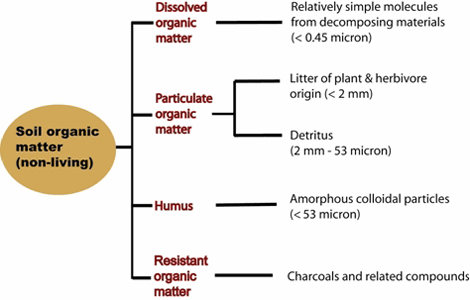Forms and Function
Decomposition | Forms and Function | Management of Soil Organic Matter | Carbon Cycle
Soil organic matter is anything in the soil of biological origin. Carbon is its key component comprising about 58 % by weight. Simple assessment of total organic matter is obtained by measuring organic carbon in soil.
Living organisms (including roots) comprise about 15 % of the total organic matter in soil. These are critical to operation of the soil carbon cycle and are discussed on the soil biology pages. Here the remaining 85 % of organic matter is discussed - the non living component.
Non-living organic matter has been grouped into four distinct categories (Baldock and Skjemstad 1999) on the basis of size, behaviour and persistence.

These categories are arranged in order of decreasing ability to decompose. Each of them contribute to soil health in different ways, as is described by Baldock and Skjemstad (1999).
Dissolved organic matter
This is the material which dissolves in soil water. It comprises the relatively simple organic compounds (e.g. organic acids, sugars and amino acids) which easily decompose. It has a turnover time of less than 12 months. Exudates from plant roots (mucilages and gums) are included here.
Particulate organic matter
Particulate organic matter retains evidence of cellular structure. It includes steadily decomposing plant litter and animal faeces, and the detritus from micro-organism activity. Most of it is continually undergoing decomposition by micro-organisms (when conditions are sufficiently moist) and has a turnover time of less than 10 years. The less active part of this category may take 15 to 100 years to turnover. Where it is still at the soil surface and relatively fresh, particulate organic matter intercepts the energy of raindrops and protects physical soil surfaces from damage. As it is decomposes, particulate organic matter provides much of the energy required by soil organisms as well as providing a steady release of nutrients into the soil environment.
Humus
Humus is usually the largest proportion of organic matter in soil comprising 45 to 75 %. Typically it adheres to soil minerals, and thus plays an important role in structuring soil.
Humus is the end product of soil organism activity, is chemically complex, and does not have recognisable characteristics of its origin. Humus is of very small unit size and has large surface area in relation to its weight. It holds nutrients, has a high water holding capacity, has a significant cationic exchange capacity (increasing with pH), buffers pH change, and can hold cations.
Humus is quite slow to decompose and exists in soil for decades. It is not biologically inert, but it is very resistant to modification and change. It is dark in colour and is responsible for the characteristic appearance of soil of high organic content. It is a key contributor to the development and stabilisation of good soil structure. Humus is an important source of soil nutrients.
Resistant organic matter
Resistant organic matter is also termed inert organic matter. It comprises material of high carbon content and includes charcoal, charred plant materials, graphite and coal. Turnover times are long and estimated in hundreds of years.
It is not biologically active but contributes positively to soil structural properties, including water holding capacity, cation exchange capacity and thermal properties.


